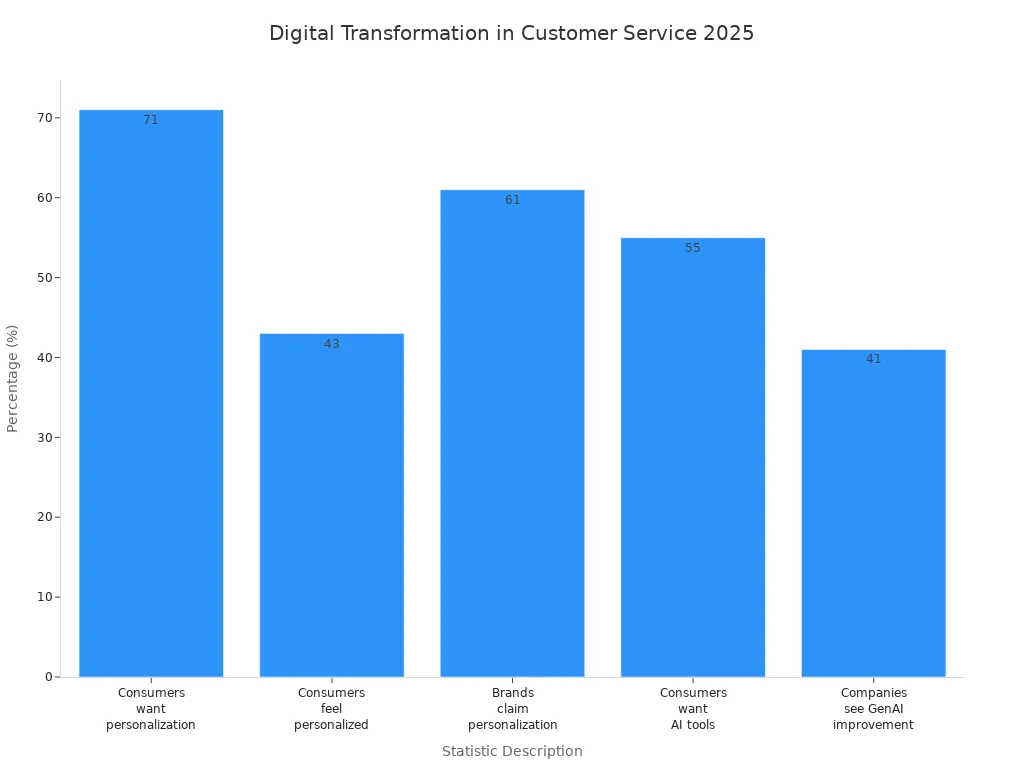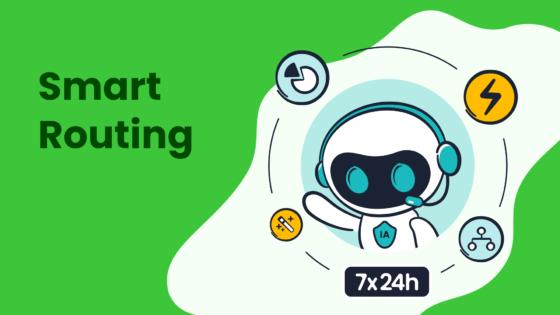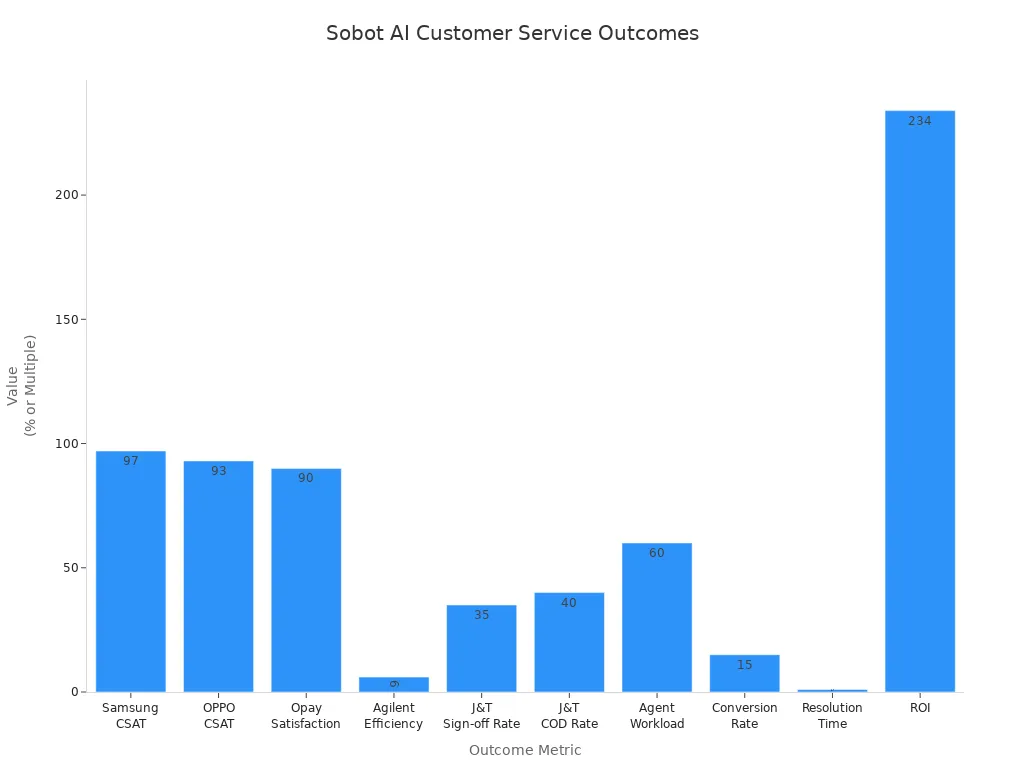Emerging Challenges of Customer Service in a Digital-First World

The pace of customer service transformation in 2025 sets a new standard for every industry. Companies now face the challenges of customer service shaped by rapid AI adoption, the need for a human touch, strict data privacy, and rising omnichannel expectations. The future of customer service depends on how leaders respond to these emerging trends. As 87% of organizations use technology to boost profits and 54% focus on modernizing customer touchpoints, customer service trends shift quickly. Many brands invest in Sobot AI to keep up with the future of customer service, using advanced tools to meet the demands of 2025. The following chart highlights how emerging trends in 2025 reshape the landscape:

Leaders who ignore these shifts risk falling behind as the future of customer service becomes more complex. Sobot empowers organizations to adapt and thrive in the evolving world of customer service transformation.
Challenges of Customer Service in 2025
The challenges of customer service in 2025 have become more complex than ever before. Support teams must adapt to rapid changes in technology, shifting customer expectations, and the growing operational demands of digital channels. As the future of customer service unfolds, organizations face a landscape shaped by ai-driven automation, digital-native customers, and the need for seamless customer experiences. Sobot’s industry experience, including its work with OPPO, highlights how leading brands address these challenges and set new standards for customer service transformation.
AI and Automation
Support teams in 2025 rely heavily on ai-driven automation to manage high inquiry volumes and deliver faster responses. By 2025, 85% of customer interactions will occur without a human representative, showing a dramatic rise in ai-first customer service. Companies use AI-powered chatbots and virtual agents to resolve up to 80% of routine requests, which increases agent productivity and reduces operational costs. Sobot’s AI solutions, for example, help brands like OPPO automate repetitive tasks and route complex issues to human agents, achieving an 83% chatbot resolution rate and a 94% positive feedback rate.
However, the challenges of customer service do not end with automation. Support teams must balance technology with empathy, as 71% of customers still prefer human interaction for complex needs. AI requires ongoing supervision and customization to avoid robotic responses and ensure ethical behavior. Integration with existing systems and continuous workflow optimization add further complexity. Sobot addresses these issues by offering AI tools that support both automation and human collaboration, ensuring that customer experiences remain personal and effective.
Tip: Support teams should regularly audit their AI systems to maintain accuracy and customer trust.
Rising Customer Expectations
Customer expectations in 2025 have reached new heights. Digital-native customers demand hyper-personalized, real-time service across every channel. Research shows that 93% of support teams report higher customer expectations than ever before. Customers want seamless, context-aware experiences that follow them from chat to phone to social media, with brands anticipating their needs before they even ask.
Personalization now goes beyond using a customer’s name. Brands must deliver dynamic, relevant experiences that adapt to factors like time of day and local trends. AI-driven automation enables this level of service, but only when paired with transparent data practices. In fact, 79% of consumers trust companies more when they explain how data is used and give customers control. Meeting these expectations drives customer satisfaction and loyalty—88% of customers say good service increases their likelihood to repurchase, and loyal customers spend 140% more than those with poor experiences (Harvard Business Review).
Sobot’s unified workspace and omnichannel solutions help support teams deliver on these rising expectations. By integrating chat, voice, and social channels, Sobot enables brands to provide consistent, personalized customer experiences that build trust and drive satisfaction.
Complexity of Digital Channels
The explosion of digital channels in 2025 has created new challenges of customer service for support teams. Customers interact with brands through chat, email, voice, SMS, and social media, often switching channels mid-conversation. Managing these interactions requires advanced tools and seamless integration to avoid data silos and inconsistent experiences.
| Factor | Description | Impact on Managing Digital Channels |
|---|---|---|
| Data Volume | Massive growth in data from multiple sources | Strains processing capacity, increases integration needs |
| Data Variety | Different formats and sources | Requires complex transformation and unification |
| Integration Challenges | Combining legacy and new systems | Leads to siloed data, inconsistent customer views |
| Real-time Processing | Need for instant data action | Adds pressure for seamless interactions |
| Business Growth | Mergers, new products, and channels | Amplifies complexity and risk of errors |
A 2024 Harvard Business Review report found that 64% of organizations struggle with the rapid increase in consumer-facing channels, and only 20% describe their customer journeys as truly seamless. Support teams must unify data and processes to deliver a consistent customer experience. Sobot’s omnichannel platform addresses these challenges by consolidating all customer interactions into a single workspace, enabling real-time insights and smooth transitions between channels. This approach empowers support teams to manage complexity and deliver the future of customer service.
Note: Leading organizations continuously train support teams and use analytics to adapt their omnichannel strategies, ensuring they stay ahead of customer service trends in 2025.
The challenges of customer service in 2025 require support teams to embrace ai-driven automation, meet rising customer expectations, and manage the complexity of digital channels. Sobot’s solutions, proven by industry leaders like OPPO, provide the tools and expertise needed to thrive in the future of customer service.
AI Solutions and the Human Touch

Sobot AI Integration
Support teams in 2025 face high inquiry volumes and complex customer needs. Sobot’s ai-driven automation tools, such as chatbots and the Voice/Call Center, help support teams manage these demands efficiently. By automating routine questions, Sobot allows agents to focus on more complex issues that require the human touch. Companies using Sobot AI have seen up to an 85% chatbot resolution rate and a 30% reduction in workload. For example, OPPO improved its customer satisfaction score to 93% and increased its repurchase rate by 57% after integrating Sobot’s ai customer service tools. Other organizations, like Samsung and Agilent, also report significant gains in efficiency and satisfaction.

Balancing Automation and Empathy
Support teams must balance ai-driven automation with keeping the human touch. Automation handles repetitive tasks, but customers still expect personalized service and empathy. Studies show that 71% of consumers want personalized experiences, and 76% feel frustrated without them. AI systems with emotional recognition can boost satisfaction by up to 30% (MIT Media Lab). Sobot’s platform uses sentiment analysis to detect customer emotions and routes complex cases to human agents. This approach ensures that support teams deliver both speed and empathy, building trust and loyalty.
Note: Personalizing automated responses and using emotional AI can make interactions feel more human.
Human-Machine Collaboration
Effective human-machine collaboration helps support teams deliver superior service. Best practices include automating routine tasks, training agents to work with AI, and refining processes based on feedback. Sobot’s hybrid model allows chatbots to resolve simple issues while human agents handle sensitive or complex requests. OPPO’s experience shows that this approach leads to faster response times and higher customer satisfaction. Research confirms that hybrid models outperform fully automated systems, offering better resolution rates and more personalized experiences. Support teams using Sobot benefit from real-time insights and seamless transitions between AI and human agents, ensuring customers always receive the right level of care.
Omnichannel Experience with Sobot
Unified Customer Journeys
In 2025, companies must deliver unified customer journeys to meet rising expectations. Customers often begin their journey on a search engine and then choose how and where to interact. They expect seamless experiences as they move between digital channels. Research shows that 76% of consumers are more likely to buy from brands that personalize their experience. Omnichannel strategies reveal new demand by making customer journeys low-effort and connected. Customers want to switch devices or channels without losing progress. Nick Latham, a customer experience expert, notes that people expect right-first-time interactions that blend digital and human touchpoints in 2025.
Companies that focus on unified journeys see more customer interactions and higher satisfaction. Sobot’s platform brings together sales, marketing, and support, making it easier to deliver personalized experiences at every step.
- Customers start on Google and move to chat, voice, or social media.
- 76% prefer brands that personalize their journey.
- Omnichannel experiences uncover new opportunities for engagement.
- Integration allows customers to switch channels without disruption.
- Customers expect low-effort, seamless experiences in 2025.
Voice/Call Center Integration

Voice and call center integration play a key role in omnichannel experiences in 2025. Sobot’s Voice/Call Center connects with digital platforms to create a consistent customer experience. This integration ensures that every interaction, whether by phone or online, feels connected and easy. Automation tools like chatbots handle routine tasks, freeing agents to focus on complex issues. Sobot’s unified workspace combines chat, calls, and social media, boosting team productivity and ensuring consistent service quality.
- Omnichannel experience: Customers receive the same level of service across all channels.
- Improved satisfaction: Personalized service and efficient support lead to happier customers.
- Better efficiency: Automation reduces manual work and errors.
- Lower costs: IVR and automation decrease staffing needs.
- Enhanced analytics: Real-time data helps teams improve customer experience in 2025.
Seamless Channel Switching
Seamless channel switching is essential for customer retention in 2025. Companies with strong omnichannel strategies retain 89% of their customers, compared to only 33% for those with weak strategies (source). Sobot enables customers to move between chat, voice, WhatsApp, and other channels without losing context. This reduces friction and builds trust. Consistent branding and messaging across channels support long-term relationships. Sobot’s WhatsApp Business Platform and global telephony features help businesses reach new customers and provide personalized experiences worldwide.
- Seamless transitions reduce frustration and improve satisfaction.
- Consistent interactions build trust and loyalty.
- Integrated technology enables smooth data sharing and personalized experiences.
- Customer-centric feedback and analytics help anticipate needs in 2025.
Tip: Businesses that invest in seamless omnichannel experiences see higher Net Promoter Scores and customer satisfaction.
Data Security and Trust

Privacy in Digital Service
Customers today expect brands to focus on trust and privacy when handling their personal data. The rise of AI in digital customer service brings new concerns, such as data misuse and lack of transparency. Nearly 90% of consumers want the ability to view and delete their data, and 85% expect stronger privacy measures on their devices. Businesses must provide clear privacy policies and empower users with control over their information. Sobot addresses these needs by offering encrypted data transfer and GDPR-compliant solutions, ensuring that customer data stays protected at every touchpoint.

| Consumer Concern Aspect | Key Findings |
|---|---|
| Trust in online services | 50% of Gen Z and Millennials trust data protection |
| Data control | Nearly 90% want to view and delete collected data |
| Device security expectations | 85% want stronger privacy and security measures |
| Government regulation | 77% want increased regulation on data collection and use |
Note: Brands that focus on trust and privacy build a competitive edge and foster long-term loyalty.
Secure Call Center Operations
Cloud-based call centers must protect sensitive information from cyber threats. Sobot’s Voice/Call Center uses encrypted data storage and strict access controls to keep customer data safe. The platform operates with a 99.99% uptime, ensuring reliable service. Regular security updates and compliance with global standards like GDPR and HIPAA help prevent data leaks. These measures allow organizations to deliver secure customer service while maintaining operational efficiency.
Compliance and Transparency
Meeting compliance standards is essential for customer service in 2025. Regulations such as GDPR, CCPA, and PCI-DSS set strict rules for data handling and privacy. Sobot’s solutions help businesses document data assets, limit access, and implement encryption. Regular audits and transparent data practices reduce the risk of violations and build customer trust. Companies that focus on trust and privacy see measurable benefits, including higher revenue, lower costs, and improved customer satisfaction.
| Industry | Revenue Impact | Cost Reduction | Customer Satisfaction |
|---|---|---|---|
| Retail | +18.3% | -12.7% | +24.5% |
| Financial | +16.9% | -15.2% | +19.8% |
| Technology | +21.5% | -13.9% | +28.7% |
Predictive Service and Proactive Support
AI-Driven Insights
Companies now use AI-driven insights to transform customer experience predictions. AI analyzes large amounts of data to find patterns that humans often miss. For example, Amazon and Spotify use AI to study customer behavior and deliver personalized suggestions, which improves engagement and satisfaction. McKinsey reports that businesses using AI achieve an 85% sales growth advantage and over 25% gross margin improvement compared to others (source). AI segments customers by behavior and interest, not just demographics. This approach allows companies to target marketing and support more effectively. Predictive analytics also help identify customers likely to leave and offer them incentives to stay. Natural Language Processing reviews social media and support tickets to spot issues before they grow.
Companies that use AI-driven insights can deliver a more proactive support model, improving the overall customer experience.
Anticipating Customer Needs
Proactive support means solving problems before customers even ask. AI and predictive analytics help companies anticipate customer needs by studying purchase history, browsing habits, and sentiment. For example, telecom companies use AI to predict when customers might leave and take action to keep them. Netflix analyzes viewing habits to suggest new shows, keeping users engaged. Predictive analytics tools help businesses:
- Send timely reminders or suggestions based on past behavior.
- Personalize interactions at scale.
- Spot early signs of customer churn.
- Forecast support demand and schedule agents.
- Use sentiment analysis to address concerns quickly.
- Automate alerts and troubleshooting to resolve issues fast.
This proactive support approach leads to higher customer satisfaction and loyalty.
Sobot’s Analytics Tools
Sobot provides advanced analytics tools that help businesses move from reactive to proactive support. The platform collects and analyzes real-time data from every customer interaction. Sobot’s reporting features allow teams to spot trends, identify common issues, and predict future needs. For example, Sobot’s AI can forecast peak inquiry times, helping managers schedule staff more efficiently. The system also uses sentiment analysis to detect unhappy customers and trigger immediate follow-up. By using Sobot’s analytics, companies can improve customer experience, reduce churn, and boost satisfaction. Sobot’s tools make proactive support possible for organizations of any size.
Employee Training and Adaptation
Upskilling for 2025
Customer service in 2025 demands new skills and ongoing learning. Teams must keep pace with rapid changes in technology and customer expectations. The most in-demand skills for 2025 include:
- Proficiency with AI-powered tools, as agents work alongside chatbots and use AI insights to improve efficiency.
- Ability to handle omnichannel interactions across phone, email, chat, and live chat, meeting the seamless support customers expect in 2025.
- Expertise in CRM software to track interactions and personalize experiences.
- Data analysis skills to use customer history and anticipate needs.
- Strong communication and interpersonal skills to balance automation with a human touch.
- Specialization in certain technologies or business areas, which helps route inquiries to the right experts.
- Flexibility and a commitment to continuous training on AI, automation, and omnichannel communication.
Employers in 2025 look for candidates with digital agility and traditional customer service know-how. Upskilling existing staff remains a top priority as AI continues to evolve.
Adapting to New Technologies
Adapting to new technologies in 2025 requires a structured approach. Effective training methods help teams stay ahead:
- Assess current skills and identify gaps in AI knowledge.
- Design targeted training modules with scenario-based exercises.
- Implement live, hands-on training, starting with basic AI features and moving to advanced tools.
- Address concerns about AI by showing how it supports agents, not replaces them.
- Overcome resistance with demos, peer testimonials, and gradual feature rollouts.
- Promote continuous learning with regular feedback, reviews, and skill assessments.
- Foster collaboration between agents and AI, using decision trees to guide when to rely on AI or personal judgment.
These steps help teams in 2025 build confidence and adapt quickly.
Sobot’s Support and Resources
Sobot provides comprehensive support and resources to help organizations succeed in 2025. The platform offers:
- Interactive training sessions for new users and advanced users.
- Detailed documentation and tutorials for every feature.
- 24/7 technical support to resolve issues quickly.
- Regular updates on new AI features and best practices.
- A responsive team that guides implementation and ongoing optimization.
Sobot’s commitment to training ensures that customer service teams in 2025 stay skilled, confident, and ready for the future.
Adapting to the challenges of customer service in 2025 remains urgent for every organization. Companies that lead in customer service transformation combine AI, omnichannel solutions, and a human touch to meet rising customer expectations. Sobot’s all-in-one platform helps businesses deliver seamless, secure, and personalized support across every channel.
Key takeaways from successful organizations:
- Customer engagement starts before the contact center, requiring a full view of the customer journey.
- Instant gratification, emotional connection, and smart self-service powered by AI drive satisfaction.
- Personalization and omnichannel experiences build loyalty, especially with Gen Z, who expect digital-first support.
To future-proof customer service operations, organizations should:
- Audit current processes and identify gaps in omnichannel and AI capabilities.
- Invest in employee training and skill development for digital-first customer service.
- Leverage advanced solutions like Sobot to unify communication, automate workflows, and protect data.
| Pillar | Description | Practical Application |
|---|---|---|
| Automation | Increases efficiency and reduces errors | Use AI chatbots and workflow automation |
| Insight | Enables data-driven decisions | Employ analytics and real-time dashboards |
| Security | Protects customer data and builds trust | Implement encrypted data transfer and compliance tools |
| Agility | Supports quick adaptation to new customer needs | Adopt scalable, cloud-based contact center solutions |
The future of customer service belongs to those who act now. Explore Sobot’s solutions to stay ahead of customer service trends and deliver exceptional experiences in a digital-first world.
FAQ
What are the main challenges of customer service in 2025?
Support teams face high inquiry volumes, complex digital channels, and rising customer expectations. The challenges of customer service now include balancing AI automation with empathy and ensuring data privacy. Sobot helps companies address these issues with unified, AI-powered solutions.
How does Sobot support customer service transformation?
Sobot provides all-in-one contact center solutions. These tools help support teams automate workflows, unify communication channels, and deliver personalized experiences. Companies like OPPO have improved efficiency and customer satisfaction using Sobot’s platform.
Why is the human touch still important in the future of customer service?
Customers value empathy and personal attention. Even with advanced AI, 71% of people prefer human support for complex needs (source). Sobot combines automation with human agents to ensure every customer feels heard.
How does Sobot ensure data security for support teams?
Sobot uses encrypted data transfer, GDPR-compliant systems, and strict access controls. The platform maintains 99.99% uptime and regular security updates. These features protect sensitive information and build trust in the future of customer service.
What training does Sobot offer for adapting to new customer service technologies?
Sobot provides interactive training, detailed documentation, and 24/7 technical support. Support teams receive regular updates and best practices. This approach helps teams adapt quickly to the challenges of customer service and succeed in customer service transformation.
See Also
How AI Agents Are Transforming Customer Support Today
Best Cloud Contact Center Services Reviewed For 2024
Essential Advice For Selecting Social Media Support Tools
